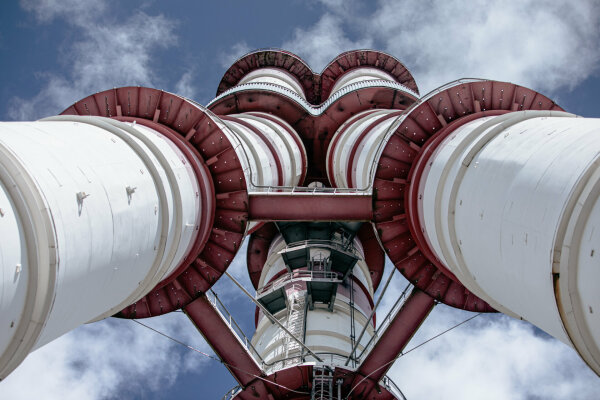Ignalina Nuclear Plant Speeds Up Work: Iconic Chimneys to Be Dismantled by 2034
2025

The upcoming new funding period for the Ignalina Nuclear Power Plant (INPP) marks an important milestone in the decommissioning process – the start of the most complex stage, involving the dismantling of reactor systems. This phase will culminate in 2034 with the beginning of dismantling the plant’s symbolic ventilation stacks.
Although the physical landscape of Lithuania’s former nuclear power plant has not changed significantly yet, 44% of the plant’s equipment – equivalent to 79,000 out of 180,000 tonnes – has already been dismantled. The decommissioning work is progressing according to plan, and over the past year, the total volume of dismantled and processed radioactive waste increased by 88%. The current processing capacity now reaches 8,000 tonnes per year. Moreover, production costs have halved: while in 2021 processing one tonne cost €9,000, last year the cost was reduced to €5,000 per tonne.
“It’s time to forget about the delays once associated with the dismantling of the Ignalina Nuclear Power Plant. On the contrary – dismantling is progressing on schedule. Each year we manage more of the historical radioactive waste, we are ahead of the demolition schedule for buildings, and we began construction of a major new near-surface repository six months earlier than planned. The company’s progress and improved efficiency were decisive arguments during this year’s negotiations with the European Commission regarding the new 2028–2034 funding period, helping us secure approval for the required budget – which is expected to be 23% higher than the current one, at €678 million. Continuing the work, we are also committed to new goals and changes to become even more efficient,” says Linas Baužys, CEO of INPP.
According to Mr Baužys, the financial donors of the Ignalina Nuclear Power Plant expect more efficient use of human resources and an increased involvement of external partners – selecting reliable Lithuanian and international contractors and suppliers through public procurement. Until now, the company has annually purchased goods and services worth an average of €70 million, and this figure is expected to grow in the future.
“To accelerate dismantling, it was decided to decommission both reactors in parallel, using more resources, rather than one after another. We will also bring forward certain works planned for the final phase of the megaproject – dismantling or demolishing equipment and structures that are still used for dismantling but are no longer cost-effective to maintain. One such example is the plant’s famous chimneys, which still serve as ventilation stacks but whose capacity is no longer needed. Therefore, we will be looking for more optimal solutions,” company’s CEO explains.
The Ignalina Nuclear Power Plant aims to begin dismantling the ventilation stacks in 2034, while the final clean-up of the former plant site is expected to be completed by 2050. However, the company’s long-term operations will continue until around the year 2100, as it will need to keep transferring waste from temporary storage facilities to final repositories, as well as operate and monitor these facilities until the radioactive waste stored within becomes non-radioactive. For example, monitoring of the existing very low-level waste repository will continue for another 100 years after its closure.
“The efficiency goals and the changing environment require organizational transformation. For many years, decommissioning activities have been largely carried out in-house – our employees have vast experience and the necessary competence. However, we are facing a new reality – an aging workforce. Currently, 15% of our employees are of retirement age, and 24% are approaching it. We always strive to preserve expertise, and as long as a person is willing and able to continue working at an honorable age, they do so. Yet, the total of 39% is a clear signal that we must review our operational structure, refine our functions, and ensure the company’s resilience and nuclear safety. Therefore, the organizational changes now underway are both necessary and aimed at the long-term sustainability of our operations,” noted Mr Baužys.
The CEO emphasizes that the coming period will demand exceptional technical precision, specialized expertise, and close cooperation with Lithuanian and international partners.
In the years ahead, the Ignalina Nuclear Power Plant faces the most technically complex and strategically important phase of its decommissioning. The dismantling phase of the reactors has already begun, involving the removal of R1 and R2 reactor zones to prepare access to the R3 zones containing the reactor cores, whose dismantling is planned to begin in 2031. By that time, the drum separators will also be dismantled, and by 2035 a new graphite storage facility for reactor waste will be constructed. To ensure the final disposal of low- and intermediate-level radioactive waste, construction of a new near-surface repository began this year and is scheduled for completion by the end of 2028.
© Photo – “Fotokablys”

